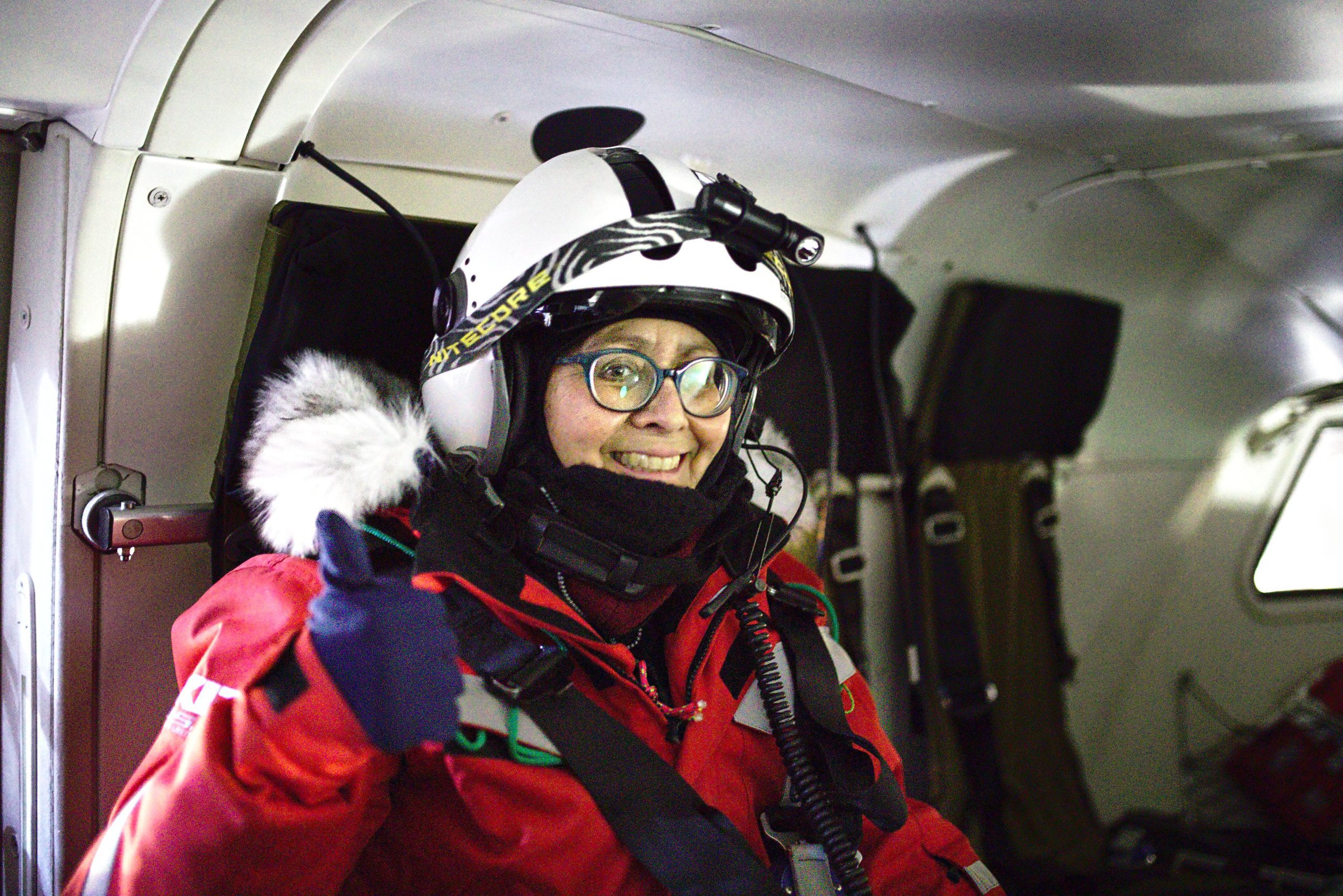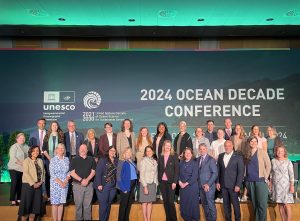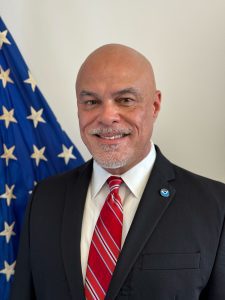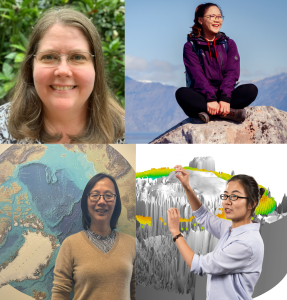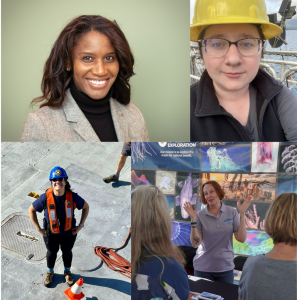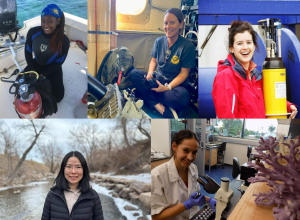A conversation with Arctic scientist Taneil Uttal
Taneil Uttal, a scientist with NOAA’s Physical Sciences Laboratory, has been studying the Arctic atmosphere, climate and more for 22 years — a career that’s made her a pro at remote Arctic living.
Uttal recently returned from a four and a half month stint in the central Arctic on the MOSAiC Expedition, an ambitious Arctic research effort led by the Alfred Wegener Institute and involving more than 400 scientists from 19 countries. Scientists on the mission are collecting data on the Arctic atmosphere, ice and ocean, with the goal of improving weather and climate forecasts — not just in the Arctic region, but globally. While on MOSAiC, Taneil lived on the German icebreaker RV Polarstern, a research ship that was frozen into the Arctic sea ice. NOAA Research sat down with Uttal, whose notable career in Arctic research recently earned her a NOAA Distinguished Career Award, to hear more about her time in the Arctic. What did you do to prepare for this Arctic expedition?
Scientists like me had extensive training before going on MOSAiC. We had firearms training and something called mariner’s training, which is a weeklong course that anyone has to have if they’re going to be a non-passenger on a vessel. We also did Arctic survival training. When we got to Tromsø, Norway, we did several extra trainings, including getting survival gear on and swimming around the Bay, just to see what it was like to be in cold water, in case we ever ended up in cold water.
MOSAiC is focused on gathering data and conducting research on the Arctic atmosphere and environment. Why is Arctic research important?
There are people and ecosystems that are in the Arctic that are affected by the environmental changes occurring there. A warmer Arctic with less ice opens the conversation on increased shipping, energy extraction, fishing, tourism and more. Scientists are researching how the changing Arctic is feeding back to change weather in the United States and the other, more inhabited lower latitudes. From this viewpoint, the Arctic is important to everyone on the planet. What did your days look like on the MOSAiC Expedition?
I had two roles on MOSAiC. The first was leading the Atmosphere team, which is one of five science teams, and the other was operating a project looking at surface energy balance, which we did with four different data-collecting installations. One was a micrometeorological tower, which told us how much energy is going from the atmosphere into the surface of the Arctic. That energy transfer from the atmosphere to the ice is one of the main controls for how the sea ice is melting, how the permafrost is melting, and how the ocean is warming up.
I would get up every morning and put my gear on, and make a trip log and a plan to go out there. We had to have a bear guard with us, to make sure no polar bears came along. So we’d walk out to the tower, and I would check that everything was still there, that we hadn’t had a crack in the ice, or that snow hadn’t drifted over our instruments. Some days, I’d also check on autonomous systems that didn’t need to be checked on every day. Those needed to be reached by helicopter, and I’d do a lot of the navigating for the helicopter.
MOSAiC takes place on a huge icebreaker trapped in the Arctic ice. What was the ship like?
The ship was a wonderful facility. There were a lot of facilities for watching movies, and they had a pool and a sauna on the ship. It sounds funny but people in the evenings would want to recreationally go walking or skiing. People were very sociable in the evenings, having social hours and playing games. I was living with the same 50 or so scientists and 50 crew members for four months, and it was very much like having a family in the Arctic. What kind of food did you eat on the expedition?
We had excellent food three times a day plus afternoon coffee breaks for people who weren’t out on the ice. It was a German ship, so there was a lot of meat, cheese, bread, potatoes, and Nutella, and they did make a strong effort to keep the vegetarians on board nicely fed as well. People in the Arctic have to eat a lot! The calories you burn just putting your clothes and gear on — it sounds funny, but it’s huge. Then once you’re outside, it’s so cold that your body starts burning calories like crazy. What kind of wildlife did you see there?
I saw polar bear tracks, and a camera that was set up to take photos every five minutes captured a polar bear going through our camp one night. Also, the first few weeks we were there, we had several Arctic foxes come by — and one of them was really a problem because it chewed up some of our tools’ cables! It’s really special seeing animals in the Arctic, because they’re not afraid of people at all. It’s amazing seeing animals in their natural habitat that haven’t been impacted by people.
What was it like to do research in the middle of the Arctic winter?
I picked going to the Arctic in the mid-winter, and everyone was saying, “Why would you do that? It’s going to be the coldest and darkest time!” And it was — the coldest temperature I experienced there was -45 degrees Fahrenheit.
Mostly it was a scientific thing — I knew that was the least known time of year scientifically. It’s very rare that people go to the Arctic in the winter, so I really wanted to see what mid-winter was like. I also knew I’d have less chance of seeing a polar bear. Polar bears are very disruptive if you’re trying to work out on the ice – they even sometimes tear your instruments apart!
How does it feel to come back home after an Arctic expedition?
It’s almost like you have to go through this adjustment period when you come home, because you’ve been in such a situation of heightened experience and sensation. Then, you come back, and everything seems crowded and overwhelming and ordinary. I didn’t have that sensation this time, though — I’ve done this many times now, so I’m used to it! The first time, it can be a huge adjustment. For some scientists, the way to cope with coming down from an Arctic expedition is to go on another expedition. How has Arctic research changed since you entered the field?
One thing that was great about MOSAiC is that there were a lot of women! The percentage of women working in the field is much more even than it used to be. The original ice camps didn’t allow women at all! In the last few decades, women started going on these expeditions, and now there’s a lot, which is great. It makes for a much more vibrant and really productive work environment.
Do you have a favorite memory from the expedition?
One of our remote sites had a failure with a fuel system — the exhaust kept freezing up. It kept forming these giant ice balls, and if they got clogged up completely, the system would fail. So we needed to fix that. My partner and I, and a bear guard were dropped off at this remote site by helicopter, and it was like we got away from it all — during an experiment that was already getting away from it all! It was a really clear night — millions of stars, it felt like we were in a bowl of stars. You never see stars down near the horizon in the U.S., but there it was so dark you could see stars all the way down to the horizon. The moon was peeking above the horizon, and there was this really faint aurora, and you could hear the ice just creaking and cracking as if it was alive. We spent four hours out there that day, and it was a pretty magical day.
What’s one thing you want the public to know about the Arctic?
Especially in the wintertime, I feel like the Arctic is this unknown part of our planet. I feel like it’s so cool that NOAA looks at the deepest oceans, and that they supported this project where I went to the North Pole in the middle of the winter. It doesn’t feel like it to people, but there are many places on this planet that are unexplored and uninhabited. The discovery science we do to find out about these places takes us on wonderful adventures, and it’s great that we can do expeditions to these undiscovered places.
